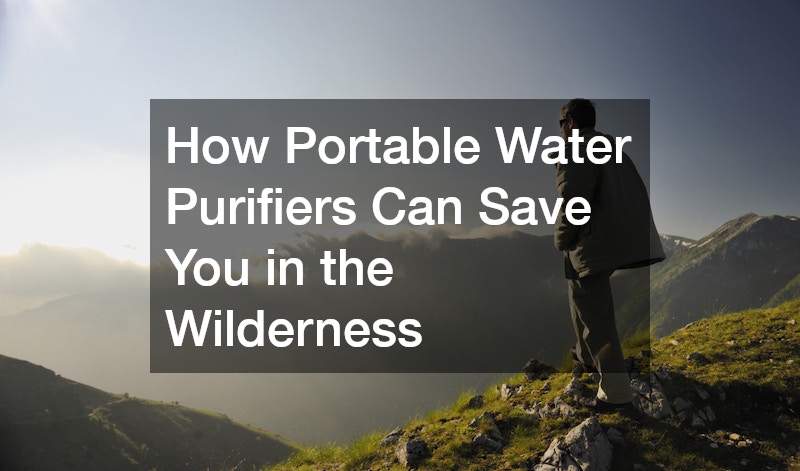This article explores the crucial role portable water purifiers play in ensuring outdoor enthusiasts have access to safe and clean drinking water while navigating the unpredictable environments of the wilderness.
The Importance of Portable Water Filtration in the Wilderness
The Risks of Untreated Water Sources
Untreated water sources in the wilderness often carry hidden dangers that are invisible to the naked eye. Waterborne pathogens such as Giardia, E.
coli, and Cryptosporidium can lurk in streams and lakes, posing significant health risks. Consuming untreated water can lead to severe illnesses that may impair one’s ability to survive and navigate.
Without access to clean water, wilderness enthusiasts are at an elevated risk of contracting illnesses such as gastroenteritis and dysentery. These conditions can cause dehydration, prolonged illness, and, in severe cases, could be life-threatening. Awareness of these risks underscores the importance of filtering all water sources in the wild.
In addition to pathogens, untreated water may contain harmful chemicals and heavy metals due to natural or human-related contamination. Water runoff from nearby industrial activities or agricultural areas can introduce pollutants that are toxic when ingested. Thus, the necessity for portable water purifiers becomes clear, as they help eliminate these contaminants effectively.
Comparisons to Traditional Water Procurement Methods
Traditional water procurement methods, such as boiling, have been common practices for purifying water in the wilderness. Boiling water is effective in killing most pathogens, but it requires fuel and time, making it less practical for long hikes or emergencies. Furthermore, boiled water must be allowed to cool before consumption, which is not ideal during physically demanding activities.
In contrast, modern portable water purifiers offer a convenient and efficient alternative. These devices are designed to work quickly and require minimal resources beyond the purifier itself, making them suitable for immediate hydration needs. They allow individuals to filter water while on the move, eliminating delays and ensuring that adventurers remain adequately hydrated at all times.
While chemical treatments such as iodine or chlorine tablets have also been used, they often leave an unpleasant taste and may not be effective against all pathogens. Portable water purifiers offer the advantage of preserving the taste of water while ensuring comprehensive pathogen removal. This makes them highly desirable for those who prefer a more natural taste with greater safety.
Choosing the Right Portable Water Purifier
Understanding Different Types of Water Purifiers
There are various types of portable water purifiers available on the market, each with its unique advantages. Pump filters use a manual pumping action to force water through a filter, trapping contaminants in the process. Gravity filters, on the other hand, rely on the force of gravity, making them useful for group water purification where no manual effort is required.
In addition to pump and gravity filters, UV purifiers offer a technologically advanced solution by using ultraviolet light to kill pathogens in a matter of seconds. UV purifiers are lightweight and easy to carry, which makes them ideal for backpackers who prioritize portability. However, they require batteries or a solar charge, so it’s crucial to have an energy source readily available.
Key Features to Consider
When selecting a portable water purifier, weight and size are critical factors, especially for those who prefer lightweight gear. A purifier that is too heavy or bulky can become a burden, whereas a compact design ensures that the equipment can be packed easily alongside other essentials. Balancing functionality with portability ensures maximum convenience during outdoor excursions.
Another important consideration is the filter’s speed and flow rate, as a faster purifier can significantly ease the process of obtaining safe water. Some purifiers can filter several liters per minute, allowing for quick hydration and minimal wait times. An efficient flow rate is beneficial in scenarios where immediate access to water is necessary.
The Best Practices for Using Portable Water Purifiers in the Wild
Proper Usage Techniques
Proper usage techniques are essential to ensure the effectiveness and safety of water purifiers while in the wilderness. It’s crucial to read and follow the manufacturer’s instructions thoroughly to avoid user errors. Operators should always ensure the intake area is free from visible dirt or debris before using the purifier to eliminate the possibility of clogging.
It’s advisable to carry a pre-filter when utilizing pump or gravity filters to prevent large particles from entering the purifier. This not only extends the life of the device but also guarantees that it functions efficiently. When using a UV purifier, maintain steady stirring to ensure the UV light reaches all parts of the water.
Maintenance and Longevity Tips
Regular maintenance of portable water purifiers is necessary to extend their lifespan and maintain optimal performance. After each use, it is advisable to clean and dry all components to prevent mold growth and bacterial contamination. Storing the purifier in a dry place when not in use will further safeguard its condition.
Filters have a limited lifespan and must be replaced according to the manufacturer’s guidelines to ensure effective performance. Monitoring the filter’s condition and performance during use can help identify when a replacement might be necessary. Neglecting filter changes can reduce the purifier’s ability to remove contaminants effectively.
Portable water purifiers are indispensable tools for wilderness survival, providing safe hydration options and protecting outdoor enthusiasts from various health threats associated with untreated water. Their advantages over traditional water purification methods and the ability to suit different wilderness environments make them an essential part of any outdoor survival kit. By understanding how to choose, use, and maintain these devices, adventurers can enjoy the wilderness with greater confidence and safety.


